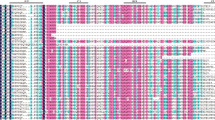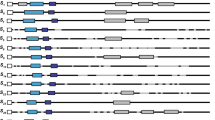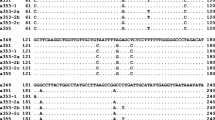Abstract
Apricot (Prunus armeniaca L.) shows gametophytic self-incompatibility controlled by a single locus with several allelic variants. An allele for self-compatibility (S C ) and seven alleles for self-incompatibility (S1–S7) were described previously. Our experiments were carried out to ascertain whether the number of allelic variants of apricot S-locus was indeed so small. Twenty-seven apricot accessions were analysed for stylar ribonucleases by non-equilibrium pH gradient electrofocusing (NEpHGE) to determine their S-genotype. To validate the results of electrofocusing, the applicability of the S-gene-specific consensus PCR primers designed from sweet cherry sequences was tested. NEpHGE revealed 12 bands associated with distinct S-alleles in newly genotyped cultivars. Cherry consensus primers amplified 11 alleles out from 16 ones, which indicated that these primers could also recognize most of the S-RNase sequences in apricot, and provided an efficient tool to confirm or reject NEpHGE results. By combining the protein and DNA-based methods, complete or partial S-genotyping was achieved for 23 apricot accessions and nine putatively new alleles (provisionally labelled S8–S16) were found. Their identity needs to be confirmed by pollination tests or S-allele sequencing. This study provides evidence that similarly to other Prunus species, the S-locus of apricot is more variable than previously believed.
Similar content being viewed by others
References
Alburquerque, N., J. Egea, O. Pérez-Tornero & L. Burgos, 2002. Genotyping apricot cultivars for self-(in)compatibility by means of RNases associated with S alleles. Plant Breed 121: 343–347.
Bošković, R. & K.R. Tobutt, 1996. Correlation of stylar ribonuclease zymograms with incompatibility alleles in sweet cherry. Euphytica 90: 245–250.
Bošković, R., K.R. Tobutt, H. Duval, I. Batlle, F. Dicenta, & F.J. Vargas, 1999. A stylar ribonuclease assay to detect self-compatible seedlings in almond progenies. Theor Appl Genet 99: 800–810.
Brózik, S. & J. Nyéki, 1975. A kajszi termékenyülési viszonyai. In: S. Brózik & J. Nyéki (Eds.), Gyümölcstermő növények termékenyülése, pp. 173–176. Mezőgazdasági Kiadó, Budapest.
Burgos, L., J. Egea, R. Guerriero, R. Viti, P. Monteleone & J.M. Audergon, 1997a. The self-compatibility trait of the main apricot cultivars and new selections from breeding programmes. J Hortic Sci 72: 147–154.
Burgos, L., C.A. Ledbetter, O. Pérez-Tornero, F. Ortín-Párraga & J. Egea, 1997b. Inheritance of sexual incompatibility in apricot. Plant Breed 116: 383–386.
Burgos, L., O. Pérez-Tornero, J. Ballester & E. Olmos, 1998. Detection and inheritance of stylar ribonucleases associated with incompatibility alleles in apricot. Sex Plant Reprod 11: 153–158.
Cociu, V., 1993. The Apricot (in Romanian). Editura Ceres, Bucuresti.
Egea, J. & L. Burgos, 1996. Detecting cross-incompatibility of three North-American apricot cultivars and establishing the first incompatibility group in apricot. J Am Soc Hortic Sci 121: 1002–1005.
Egea, J., E. Garcia, L. Egea & T. Berenguer, 1991. Self-incompatibility in apricot cultivars. Acta Hortic 293: 285–293.
Entani, T., M. Iwano, H. Shiba, F.-S. Che, A. Isogai & S. Takayama, 2003. Comparative analysis of the self-incompatibility (S-) locus region of Prunus mume: Identification of a pollen-expressed F-box gene with allelic diversity. Genes Cells 8: 203–213.
Horn, J., 1939. Kajszi-, cseresznye-, meggytermesztés. Növényvédelem és Kertészet Kiadása, Budapest.
Igic, B. & J.R. Kohn, 2001. Evolutionary relationships among self-incompatibility RNases. Proc Natl Acad Sci USA 98: 13,167–13,171.
Karayiannis, I. & A. Tsaftaris, 1999. Investigation on the inheritance of self-incompatibility in apricot (Prunus armeniaca L.) among F1 generation descendants. Acta Hortic 488: 295–301.
Kostina, K.F., 1970. Self-fertility studies in apricot (in Russian). Trud Gos Nikit Botan Sada XLV: 7–17.
Ma, R.-C. & M.M. Oliveira, 2002. Evolutionary analysis of S-RNase genes from Rosaceae species. Mol Genet Genomics 267: 71–78.
McClure, B.A., V. Haring, P.R. Ebert, M.A. Anderson, R.J. Simpson, F. Sakiyama & A.E. Clarke, 1989. Style self-incompatibility gene products of Nicotiana alata are ribonucleases. Nature 342: 955–957.
Mehlenbacher, S.A., V. Cociu & L.F. Hough, 1991. Apricots (Prunus). In: J.N. Moore & J.R. Ballington (Eds.), Genetic Resources of Temperate Fruit and Nut Crops, pp. 65–107. International Society for Horticultural Science, Wageningen.
de Nettancourt, D., 1977. Incompatibility in angiosperms. In: Monographs on Theoretical and Applied Genetics, Springer-Verlag, Berlin Heidelberg New York, Vol. 3.
Nyujtó, F., S.J. Brózik, S. Brózik & J. Nyéki, 1985. Fruit set in apricot varieties. Acta Agron Acad Sci Hung 34: 65–72.
Pedryc, A., 1996. New early ripening apricot varieties bred at Faculty of Horticulture in Budapest. Results of using the gene resources of apricots and peaches, Breclav. In: Book of Abstracts, pp. 43–48.
Pedryc, A., 2003. A kajszi nemesítése. In: B. Pénzes & L. Szalay (Eds.), Kajszi, Mezőgazda Kiadó, Budapest, pp. 53–84.
Romero, C., A. Pedryc, V. Munoz, G. Llácer & M.L. Badenes, 2003. Genetic diversity of different apricot geographical groups determined by SSR markers. Genome 46: 244–252.
Romero, C., S. Vilanova, L. Burgos, J. Martínez-Calvo, M. Vicente, G. Llácer & M.L. Badenes, 2004. Analysis of the S-locus structure in Prunus armeniaca L. Identification of S-haplotype specific S-RNase and F-box genes. Plant Mol Biol 56: 145–157.
Schultz, J.H., 1948. Self-incompatibility in apricots. Proc Am Soc Hortic Sci 51: 171–174.
Smykov, V.K., 1989. Abrikos (in Russian), VO Agropromizdat, Moscow, 129 pp.
Sonneveld, T., T.P. Robbins, R. Bošković & K.R. Tobutt, 2001. Cloning of six cherry self-incompatibility alleles and development of allele-specific PCR detection. Theor Appl Genet 102: 1046–1055.
Sonneveld, T., K.R. Tobutt & T.P. Robbins, 2003. Allele-specific PCR detection of sweet cherry self-incompatibility (S) alleles S1 to S16 using consensus and allele-specific primers. Theor Appl Genet 107: 1059–1070.
Surányi, D. & L. Molnár, 1981. A kajszibarackfa élettana. In: F. Nyujtó & D. Surányi (Eds.), Kajszibarack, p. 203. Mezőgazdasági Kiadó, Budapest.
Szabó, Z. & J. Nyéki, 1991. Blossoming, fructification and combination of apricot varieties. Acta Hortic 293: 295–302.
Szabó, Z., J. Nyéki, A. Andrásfalvy, L. Szalay & A. Pedryc, 1999. Evaluation of some Romanian apricot varieties in Hungary. Acta Hortic 488: 211–214.
Tao, R., H. Yamane, A. Sugiura, H. Murayama, H. Sassa & H. Mori, 1999. Molecular typing of S-alleles through identification, chracterization and cDNA cloning for S-RNases in sweet cherry. J Am Soc Hortic Sci 124: 224–233.
Tobutt, K.R., R. Bošković, R. Cerović, T. Sonneveld & D. Ružić, 2004. Identification of incompatibility alleles in the tetraploid species sour cherry. Theor Appl Genet 108: 775–785.
Ushijima, K., H. Sassa, R. Tao, H. Yamane, A.M. Dandekar, T.M. Gradziel & H. Hirano, 1998. Cloning and characterization of cDNAs encoding S-RNases from almond (Prunus dulcis): Primary structural features and sequence diversity of the S-RNases in Rosaceae. Mol Gen Genet 260: 261– 268.
Ushijima, K., H. Yamane, A. Watari, E. Kakehi, K. Ikeda, N.R. Hauck, A.F. Iezzoni & R. Tao, 2004. The S haplotype-specific F-box protein gene, SFB, is defective in self-compatible haplotypes of Prunus avium and Prunus mume. Plant J 39: 573– 586.
Wilson, C.M., 1971. Plant nucleases III. Polyacrylamide gel electrophoresis of corn ribonuclease isoenzymes. Plant Physiol 48: 64–68.
Yaegaki, H., T. Shimada, T. Moriguchi, H. Hayama, T. Haji & M. Yamaguchi, 2001. Molecular characterization of S-RNase genes and S-genotypes in the Japanese apricot (Prunus mume Sieb. et Zucc.). Sex Plant Reprod 13: 251–257.
Author information
Authors and Affiliations
Corresponding author
Rights and permissions
About this article
Cite this article
Halász, J., Hegedüs, A., Hermán, R. et al. New self-incompatibility alleles in apricot (Prunus armeniaca L.) revealed by stylar ribonuclease assay and S-PCR analysis. Euphytica 145, 57–66 (2005). https://doi.org/10.1007/s10681-005-0205-7
Received:
Accepted:
Issue Date:
DOI: https://doi.org/10.1007/s10681-005-0205-7




